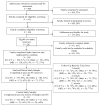Therapeutic alliance and treatment outcome in the outpatient treatment of urban adolescents: The role of callous-unemotional traits
- PMID: 27831697
- PMCID: PMC5425328
- DOI: 10.1037/pst0000093
Therapeutic alliance and treatment outcome in the outpatient treatment of urban adolescents: The role of callous-unemotional traits
Abstract
Callous-unemotional (CU) traits designate a unique subset of youth with externalizing psychopathology who have a severe pattern of aggressive behavior and tend to have worse outcomes in treatment. However, little research has addressed how CU traits relate to different components of psychotherapy, such as the therapeutic alliance. The current study examined the role of CU traits in predicting therapeutic alliance in 59 adolescents (M age = 15.3, 51% female, 64% Hispanic American, 15% African American) who were part of a larger randomized naturalistic trial of outpatient behavioral psychotherapy. Multilevel regression analysis further investigated the role of therapeutic alliance in predicting treatment outcome (as measured by self-reported delinquency) and the moderating role of CU traits. Results suggested that regardless of the severity of their externalizing problems, youth with higher levels of CU traits reported more positive ratings of therapeutic alliance. In addition, a positive therapeutic alliance predicted reductions in delinquent behavior, and this association was even stronger for youth higher in CU traits. Our results suggest that CU traits are related to improvement in the formation of the therapeutic alliance among youth with externalizing psychopathology, perhaps because these youth lack many of the social and emotional deficits that other youth with conduct problems possess. Adolescents high in CU traits should not be viewed as untreatable. Indeed, the therapeutic alliance may be an important mechanism for affecting meaningful change in these adolescents' lives. (PsycINFO Database Record
Trial registration: ClinicalTrials.gov NCT00985595.
(c) 2017 APA, all rights reserved).
Figures


Similar articles
-
Can a laboratory measure of emotional processing enhance the statistical prediction of aggression and delinquency in detained adolescents with callous-unemotional traits?J Abnorm Child Psychol. 2007 Oct;35(5):773-85. doi: 10.1007/s10802-007-9136-1. Epub 2007 May 18. J Abnorm Child Psychol. 2007. PMID: 17510788
-
Perceptions of social conflicts among incarcerated adolescents with callous-unemotional traits: 'you're going to pay. It's going to hurt, but I don't care.'.J Child Psychol Psychiatry. 2011 Mar;52(3):248-55. doi: 10.1111/j.1469-7610.2010.02336.x. Epub 2010 Nov 12. J Child Psychol Psychiatry. 2011. PMID: 21073459 Free PMC article.
-
Research review: the importance of callous-unemotional traits for developmental models of aggressive and antisocial behavior.J Child Psychol Psychiatry. 2008 Apr;49(4):359-75. doi: 10.1111/j.1469-7610.2007.01862.x. Epub 2008 Jan 21. J Child Psychol Psychiatry. 2008. PMID: 18221345 Review.
-
[The relationship between reactive/proactive aggression, callous/unemotional traits and behavioural problems in Hungarian adolescents].Psychiatr Hung. 2013;28(1):48-56. Psychiatr Hung. 2013. PMID: 23689436 Hungarian.
-
Evaluating Callous-Unemotional Traits as a Personality Construct.J Pers. 2015 Dec;83(6):710-22. doi: 10.1111/jopy.12114. Epub 2014 Aug 19. J Pers. 2015. PMID: 25039236 Review.
Cited by
-
The relationship between nature exposure and depression among Chinese prisoners: a moderated mediation model.Front Psychol. 2024 Feb 21;15:1252864. doi: 10.3389/fpsyg.2024.1252864. eCollection 2024. Front Psychol. 2024. PMID: 38449757 Free PMC article.
-
Possible Interventions for Preventing the Development of Psychopathic Traits among Children and Adolescents?Int J Environ Res Public Health. 2021 Dec 31;19(1):409. doi: 10.3390/ijerph19010409. Int J Environ Res Public Health. 2021. PMID: 35010668 Free PMC article. Review.
-
Determinants and Outcomes of the Therapeutic Alliance in Treating Justice-Involved Youth: A Systematic Review of Quantitative and Qualitative Research.Clin Child Fam Psychol Rev. 2022 Dec;25(4):658-680. doi: 10.1007/s10567-022-00407-2. Epub 2022 Aug 16. Clin Child Fam Psychol Rev. 2022. PMID: 35972713 Free PMC article.
-
Therapeutic alliance in family therapy and clinical outcomes among adolescents at risk for mood disorders.J Affect Disord. 2022 Mar 1;300:66-70. doi: 10.1016/j.jad.2021.12.088. Epub 2021 Dec 22. J Affect Disord. 2022. PMID: 34952128 Free PMC article.
-
A network analysis of the heterogeneity and associated risk and protective factors of depression and anxiety among college students.Sci Rep. 2025 Feb 25;15(1):6699. doi: 10.1038/s41598-025-91025-9. Sci Rep. 2025. PMID: 40000716 Free PMC article.
References
-
- Achenbach TM. Manual for the Child Behavior Checklist/4–18 and 1991 profile. Burlington: University of Vermont, Department of Psychiatry; 1991a.
-
- Achenbach TM. Manual for the Youth Self-Report and 1991 profile. Burlington: University of Vermont, Department of Psychiatry; 1991b.
-
- American Psychiatric Association. Diagnostic and statistical manual of mental disorders. (4) 2000 doi: 10.1176/appi.books.9780890423349. text rev. - DOI
Publication types
MeSH terms
Associated data
Grants and funding
LinkOut - more resources
Full Text Sources
Other Literature Sources
Medical

